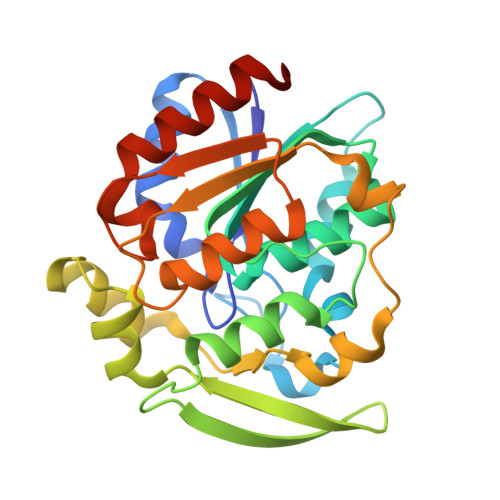Crystal structure of a seven-substitution mutant of hydroxynitrile lyase from rubber tree.
Pierce, C.T., Greenberg, L.R., Walsh, M.E., Shi, K., Magee, D.J., Aihara, H., Gordon, W., Evans 3rd, R.L., Kazlauskas, R.J.(2025) Acta Crystallogr F Struct Biol Commun 81: 398-405
- PubMed: 40864147
- DOI: https://doi.org/10.1107/S2053230X25007034
- Primary Citation of Related Structures:
8EUO - PubMed Abstract:
The α/β-hydrolase fold superfamily includes esterases and hydroxynitrile lyases which, despite catalyzing different reactions, share a Ser-His-Asp catalytic triad. We report a 1.99 Å resolution crystal structure of HNL6V, an engineered variant of hydroxynitrile lyase from Hevea brasiliensis (HbHNL) containing seven amino-acid substitutions (T11G, E79H, C81L, H103V, N104A, G176S and K236M). The structure reveals that HNL6V maintains the characteristic α/β-hydrolase fold while exhibiting systematic shifts in backbone and catalytic atom positions. Compared with wild-type HbHNL, the C α positions in HNL6V differ by a mean of 0.2 ± 0.1 Å, representing a statistically significant displacement. Importantly, the catalytic triad and oxyanion-hole atoms have moved 0.2-0.8 Å closer to their corresponding positions in SABP2, although they remain 0.3-1.1 Å from fully achieving the configuration of SABP2. The substitutions also increase local flexibility, particularly in the lid domain covering the active site. This structural characterization demonstrates that targeted amino-acid substitutions can systematically shift catalytic geometries towards those of evolutionarily related enzymes.
- Department of Biochemistry, Molecular Biology and Biophysics, University of Minnesota, Minneapolis, Minnesota, USA.
Organizational Affiliation:
















